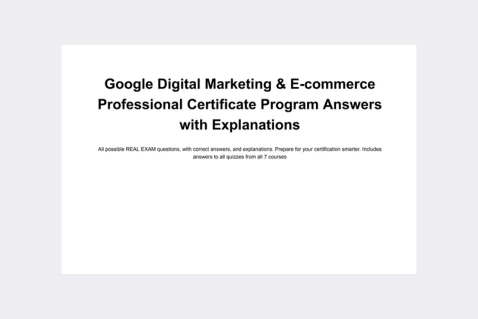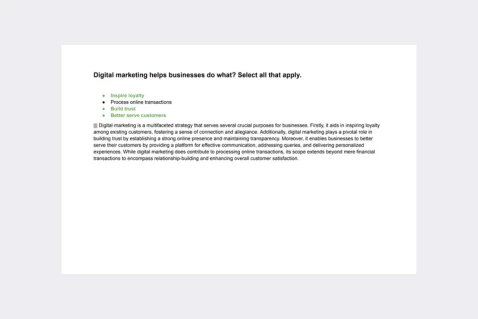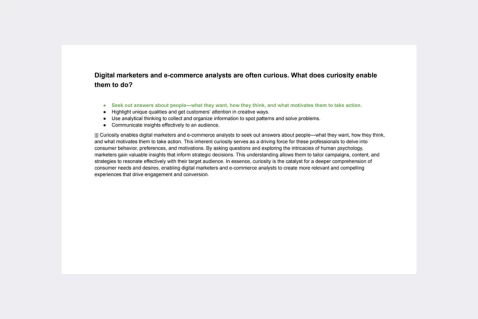Consider the following scenario: A digital marketer records a product demonstration to showcase the company’s newest arrival. If they post this recording to one of the company’s social media platforms, what content format are they using?
Video
GIF
Image
Link
Certification program: 👉 Google Digital Marketing & E-commerce Professional Certificate (Coursera)
Explanation: When a digital marketer records a product demonstration and posts it on one of the company’s social media platforms, they are using the video content format. Video content is a dynamic and engaging medium that allows marketers to showcase products, share information, and connect with their audience visually. In this scenario, the product demonstration, captured in a recorded video, enables the marketer to convey the features and benefits of the newest arrival in a more immersive and compelling way than static formats like images or links. Utilizing video content on social media enhances the storytelling capabilities, captures attention, and provides a richer experience for the audience, making it a valuable tool for digital marketing strategies.
Passing exams is not a workout. Multiple attempts won’t make you stronger.



- All possible certificate program questions
- Real certification exam questions
- Detailed answer explanations.
- Over 1700 questions, 7 courses, 30 quizzes
- Free lifetime updates.
Understanding Content Formats in Social Media Marketing
In the dynamic landscape of social media marketing, the format of content plays a crucial role in capturing audience attention, conveying brand messages, and driving engagement. From text-based posts to captivating visuals and interactive multimedia, each content format serves a distinct purpose and appeals to different audience preferences. In the scenario provided, a digital marketer records a product demonstration to showcase the company’s newest arrival. But what content format are they using, and why does it matter?
Exploring Content Formats
Content formats refer to the way information is presented and delivered to the audience on social media platforms. Some common content formats include:
- Text: Written posts, captions, or comments that convey information, ideas, or messages using text alone.
- Images: Visual content such as photographs, graphics, or illustrations that capture attention and convey messages through visuals.
- Videos: Multimedia content consisting of moving images, audio, and sometimes text overlays or animations that engage and entertain viewers.
- Audio: Content in the form of podcasts, audio clips, or voice recordings that listeners can consume on-the-go.
- Interactive Content: Engaging formats such as polls, quizzes, or interactive stories that encourage audience participation and feedback.
Identifying the Content Format
In the scenario described, the digital marketer records a product demonstration to showcase the company’s newest arrival. By recording a product demonstration, they are using the video content format. Videos are particularly effective for demonstrating product features, showcasing benefits, and providing a more immersive and engaging experience for viewers.
Practical Insights
Here are some practical insights related to leveraging different content formats in social media marketing:
-
Know Your Audience: Understand the preferences and behaviors of your target audience to determine which content formats resonate best with them. Experiment with different formats to see what generates the most engagement and response.
-
Tailor Content to Platform: Each social media platform has its own specifications and best practices for content formats. Adapt your content to fit the platform’s requirements and optimize it for maximum impact.
-
Tell Compelling Stories: Use storytelling techniques to create engaging content that captures attention and evokes emotions. Whether through text, images, or video, storytelling can make your content more memorable and impactful.
-
Embrace Visuals: Visual content tends to perform well on social media due to its eye-catching nature. Incorporate high-quality images, graphics, and videos into your content strategy to stand out in crowded feeds.
-
Experiment and Iterate: Don’t be afraid to experiment with new content formats and techniques. Monitor performance metrics and gather feedback to iterate and refine your approach over time.
By leveraging the right content formats in your social media marketing efforts, you can effectively communicate your brand messages, showcase products or services, and engage with your audience in meaningful ways.
In conclusion, the content format used by the digital marketer in the scenario—recording a product demonstration—is video. By choosing the appropriate content format, businesses can effectively showcase their offerings, capture audience attention, and drive engagement on social media platforms.
Discover our best-value guides
- Special Bundle Offer Google_Ads_Roll
- Special Bundle Offer HubSpot_Exams_Roll
- Special Offer Unchained_Guru_Roll
- Special Bundle Offer Amazon_Roll
- Special Bundle Offer Google_Analytics_Roll
- Special Bundle Offer Google_SkillShop_Roll
- Special Bundle Offer Marketing_Platforms_Roll
- Special Bundle Offer Microsoft_Advertising_Roll
- Special Bundle Offer YouTube_Roll
- Special Bundle Offer Google_Android_Roll
- Ultimate PMP certification preperation guide
- Google Cloud Professional Architect Certification Exam Answers - Ultimate Guide
- Special Bundle Offer SEMrush_Roll